Police Horse Training - Extraordinary Animals
So how can an animal so sensitive that it can detect a rider`s heartbeat work in such a hazardous environment? Well, it`s not easy. There are at least 9.2 million horses in the United States. Some are for work, others are pets or show horses, but only a few, a very few, will ever be considered suitable candidates for police work.
Talent scouts scour the nation looking for the best and the brightest horses they can find. On the few occasions they find one, that horse will then be put through a rigorous month long physical and mental assessment to ascertain if they do indeed have the right stuff.

One of the things they look for when purchasing a new horse is how smart he is. They take him out, see what he jumps at, what he`s scared of. Then the next day, they will do the same thing and see if he jumps again. If he doesn`t jump at it, that means he`s learning. But if the horse keeps jumping at or he breaks out in a sweat, that means he`s not good for police work.
Only one in ten horses will make it through basic training. That`s a 90% drop rate, which means it`s harder to get into the SFPD horse unit than it is for a recruit to make it through the US Navy Seal selection process. And that`s a tough selection process detail. Only 10% of the horses that are brought in will make it through the training period.
All that training is worth it because conservative estimates put the value of one police horse on duty the same as ten policemen on foot. Every time I hear a horse is equal to ten foot soldiers, that`s a well trained officer and a well trained horse that`s used to whatever sensory problems that are coming up.
Well, as we`ve established, horses by nature are flight creatures. But if they trust their riders, they will become accustomed to these noises. It`s also the rider that would calm the horse and send this message through his seat up to that brain in the front that says, I`m going to take care of you. You`re going to take care of me at this point. It`s in fact the horses and their riders developing their crowd control skills.
The ball is used to approaching sometimes, and the new riders come out here and they think that they`re pushing with the face of the horse. What they`re doing is they`re two tracking in and the shoulder is the one that if we ever have to move into people, that`s what the ball teaches right there. All this training does two things. One, the horse becomes accustomed to the sight, smells and sounds that are commonplace in crowds. And two, it builds an all important bond between the rider and his mount.

Talent scouts scour the nation looking for the best and the brightest horses they can find. On the few occasions they find one, that horse will then be put through a rigorous month long physical and mental assessment to ascertain if they do indeed have the right stuff.

Only one in ten horses will make it through basic training. That`s a 90% drop rate, which means it`s harder to get into the SFPD horse unit than it is for a recruit to make it through the US Navy Seal selection process. And that`s a tough selection process detail. Only 10% of the horses that are brought in will make it through the training period.
All that training is worth it because conservative estimates put the value of one police horse on duty the same as ten policemen on foot. Every time I hear a horse is equal to ten foot soldiers, that`s a well trained officer and a well trained horse that`s used to whatever sensory problems that are coming up.
The ball is used to approaching sometimes, and the new riders come out here and they think that they`re pushing with the face of the horse. What they`re doing is they`re two tracking in and the shoulder is the one that if we ever have to move into people, that`s what the ball teaches right there. All this training does two things. One, the horse becomes accustomed to the sight, smells and sounds that are commonplace in crowds. And two, it builds an all important bond between the rider and his mount.



 Training Police Horses (1967)
Training Police Horses (1967)























